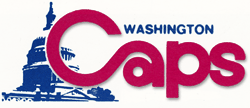
 |
Washington CapsYear of existence: 1969-70
|
Back to "Remember the ABA" Main Page
Did
you see an Oakland Oaks game? Or, did you have a favorite Oaks
player? Contribute to this web page by
When Earl Foreman bought the financially troubled Oakland Oaks franchise in 1969 and moved it to Washington D.C., the team seemed to lose its soul. Coach Alex Hannum refused to follow the team to Washington and quit. Superstar Rick Barry almost quit, and only reluctantly stayed with the team. Playmaker Larry Brown followed the team to Washington, but his close friend Doug Moe did not. Moe played for the Carolina Cougars during the 1969-70 season. Washington's logo became a red, white and blue rendition of the U.S. Capitol building (above), but the team's uniforms stayed kelly green and gold.
Foreman hired Al Bianchi as the team's new coach. The year before, Bianchi had coached an NBA expansion team, the Seattle Supersonics, to a 30-52 record. Bianchi's job with the Caps was a frustrating one. For unknown reasons, the ABA kept the team in the Western Division. Their "Western Division" status proved to be the Caps' downfall. Faced with frequent and long plane flights between Washington D.C. and western cities like Dallas, Denver, Los Angeles, and Fresno, the Caps decided to schedule ten of their home games in neutral western cities, like Wichita, Kansas and even Mexico City, Mexico. Without the home court advantage for those games the Caps lost many of them.
During the previous season the Oaks had signed a binding contract with the Los Angeles Stars to host six doubleheaders during the 1969-70 season. The Stars had anticipated making six road trips to Oakland, only a 600 mile distance from Los Angeles. After the Oaks' move to Washington, the trip distance increased to 3,000 miles. The ABA moved two of the ill-advised doubleheaders to Fresno, but kept the other four in Washington, D.C.
The Caps were a good team when they played on their real home court, the Washington Coliseum. Washington fans certainly had something to watch, as Barry, Larry Brown and Warren Armstrong had extraordinary seasons. Brown led the ABA in assists, with 7.1 per game. Armstrong continued to improve, and averaged a strong 22.8 points per game. Barry was generally healthy and played in 52 games for the Caps, averaging 27.7 points per contest (second in the ABA, behind Denver's Spencer Haywood). However, Caps fans were reluctant to attend games because the Washington Coliseum was located in a rough neighborhood. Attendance was always poor, and the team struggled. The Caps hovered near the .500 mark the entire 1969-70 season.
When prolific scorer Rick Barry (left and middle) was healthy and enforcer Warren Armstrong (right) ruled the boards, the Caps could beat anyone in the ABA. (Photos © John Oznick and used with permission) |
||
At the end of the season, Washington had reason to look forward to the 1970 Playoffs because Barry was finally healthy. But the Caps had to play first place Denver in the opening round, and lost in a tough seven game series. Game 7 of the series was in Denver and became a fight-filled Denver blowout. During the last few minutes of the contest, a frustrated Barry scuffled with several Rockets players and was thrown out of the game.
During the course of the 1969-70 season, merger talks with the NBA were harmed by the presence of the Caps in Washington. Baltimore Bullets owner Abe Pollin intended to move the Bullets to Washington, and didn't want the Caps there when the move occurred. Encouraged by other ABA owners, Earl Foreman announced that the Washington ABA franchise was moving to Virginia for the 1970-71 season. The Virginia Squires were born, and the Washington Caps became a footnote in ABA history.
| Even when Rick Barry was hurt the Caps were dangerous -- mostly because of their excellent guard corps. Larry Brown (left) had a career year in Washington and dazzled Caps fans with his frequent assists (7.1 per game).
Mike Barrett (middle) was a rookie with Washington (after playing a year of AAU ball with the Navy), yet played in all of the team's 84 games, averaging 15 points per contest. He earned ABA all-rookie honors after the 1969-70 season. Fatty Taylor (right) was another excellent Caps rookie. He began his lengthy ABA career by averaging 8.0 points and 4.5 rebounds per game. Observers around the league noted his pesky defense and numerous steals. (Photos © John Oznick and used with permission) |
||
Caps 1969-70 Home Uniform |
Caps 1969-70 Road Uniform |
Caps 1969-70 Home Warmup |
1969-70 Season
Record: 44-40 Third Place in Western Division
1970 Playoff Results:Western Division Semifinals vs. Denver Rockets (51-33)
Rockets won series, 4-3